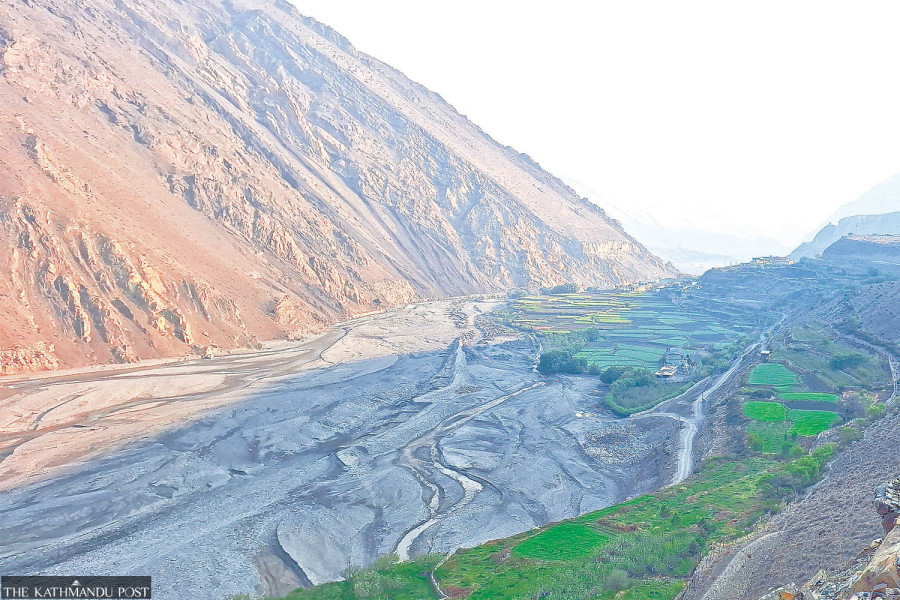Climate & Environment
Mountain livelihoods in peril as snowfall vanishes in Mustang
Farmers grapple with invasive pests, shrinking pastures, and declining tourism, as climate change threatens agriculture and livelihoods in the highlands.
Arjun Poudel
Til Bahadur Pariyar, a resident of Marpha in ward 2 of Gharapjhong Rural Municipality in the mountain district of Mustang, is feeling the pressure as the deadline to pay rent on his apple orchard approaches. In addition to the rent for the orchard, Pariyar also has to pay rent for another plot where he grows potatoes.
“I have to pay Rs50,000 to the orchard landowner and Rs30,000 for the potato field,” complained Pariyar. “I barely made Rs40,000 from selling potatoes this year, and there are no fruits on the apple trees. I could not even make Rs5,000 from apples at this time.”
This is a common refrain among many farmers of Marpha, Jomsom, Thini, and other villages in Mustang district. They are grappling with snowless winters, an alarming increase in invasive pests and pest-transmitted plant diseases, shrinking pastures, and fewer tourists. Mustang, once known for its heavy winter snowfalls, has been experiencing unusual winters—with no snowfall for the last three years.
“We have not seen snowfall in Marpha and Jomsom for the past three years,” lamented Pariyar, 61. “In all my life, I’ve never heard of Mustang going without snow.”
Like Pariyar, many residents of Mustang and other mountain districts rely heavily on agriculture, animal husbandry, and tourism.
“We used to sell apples worth more than Rs200,000 from the same orchard, and our potato harvest brought in about the same,” said Pariyar’s son Santosh. “This year, we couldn’t even cover the cost of the fertilisers we used. Instead of snowfall, all we’ve had is frost, which destroys the crops.”
Snowfall is a lifeline in the mountainous region, generally starting in November and lasting until March. Experts say that snow acts as a protective blanket, insulating dormant crops, preventing frost damage, and shielding soil from erosion.
“Thousands of local tourists used to visit Mustang just to enjoy the snow during frigid winters,” said Anita Kumari Thakali, a resident local from Thini village in ward 5 of Gharapjhong Rural Municipality, Mustang. “If this trend continues, why would anyone come to Mustang.”
Thakali, who runs a homestay, expressed concern about her business, fearing that worsening climate change could have serious impacts.
“The lack of snowfall has led to a rise in pests and diseases, which have harmed crops and plants,” added Sabi Thakali, another local from Thini village.
“Shrinking pastures due to the absence of snow have also hit animal husbandry hard. Some farmers have already given up, while others have had to reduce the number of sheep and mountain goats they keep.”
Nepal is one of the world’s most vulnerable countries to the climate crisis and has witnessed extreme weather events in the past decade and a half.
Evidence indicates that the maximum temperature in Nepal is rising at a greater rate (0.05 degrees Celsius per year) than the minimum temperature (0.03 degrees Celsius per year). Studies show most districts have witnessed increasing temperatures each year, with hill and mountain districts witnessing a faster rise than the Tarai districts.
Scores of other studies and scientific analyses over the decade, and more recently, the IPCC report, have warned that Nepal is one of the most vulnerable countries to climate change, and it cannot be business as usual to tackle the adverse impacts of the climate crisis.
Experts say climate variability is impacting the Nepali economy through reduced agricultural productivity, road damage, and increased energy imports during the dry season, among other impacts. Floods and landslides have been the most frequent hazards.
Southern and urban municipalities are more prone to flooding and heat stress, while northern regions are grappling with increased erosion, landslides, water shortages, and glacial lake overflows.
In mountain areas, people are facing multiple hardships, including crop failure, livestock deaths, shrinking pastures, and property loss, all of which have contributed to rising psychological distress.
“The impacts of climate change have become more pronounced and frequent in mountainous regions like Mustang,” said Madhukar Upadhya, a climate expert. “Snowfall has been replaced by rainfall, which has affected housing, more floods and landslides, reduced agricultural production, and dwindling water resources. What is concerning is that authorities concerned haven’t adequately prepared the people residing in these areas to cope with the adverse impacts of climate change.”
XXXXX
This photo taken earlier this year shows farmlands and the Kaligandaki river in Mustang. Farmers say the area has not seen snow for the past three years.
POST PHOTO: BASANT PRATAP SINGH




 10.45°C Kathmandu
10.45°C Kathmandu










